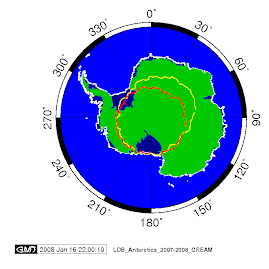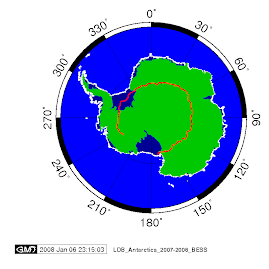The explosive event - rated "severe" to "cataclysmic" on an international scale of volcanic force - punched a massive breach in the icesheet and spat out a plume some 12,000 metres into the sky, they calculate.
Most of Antarctica is seismically stable. But its western part lies on a rift in Earth's crust that gives rise to occasional volcanism and geothermal heat, occurring on the Antarctic coastal margins.
This is the first evidence for an eruption under the ice sheet itself - the slab of frozen water, hundreds of metres thick in places, that holds most of the world's stock of fresh water.
Reporting in the journal Nature Geoscience today, the investigators from the British Antarctic Survey (BAS) describe the finding as "unique."
The volcano, located in the Hudson Mountains, blew around 207 BC, plus or minus 240 years, according to the paper.
Evidence for this comes from a British-American airborne geophysical survey in 2004-5 that used radar to delve deep under the ice sheet to map the terrain beneath.
The researchers spotted anomalous radar reflections over 23,000 square kilometres, an area bigger than Wales. They interpret this signal as being a thick layer of ash, rock and glass, formed from fused silica, that the volcano spewed out in its fury.
"We believe this was the biggest eruption in Antarctica during the last 10,000 years," BAS' Hugh Corr says.
"It blew a substantial hole in the icesheet and generated a plume of ash and gas that rose around 12 kms into the air."
The eruption occurred close to the massive Pine Island Glacier, an area where movement of glacial ice towards the sea has been accelerating alarmingly in recent decades.
"It may be possible that heat from the volcano has caused some of that acceleration," says BAS professor David Vaughan, who stresses though that global warming is by far the greater likelier cause.
Volcanic heat "cannot explain the more widespread thinning of West Antarctic glaciers that together are contributing nearly 0.2mm per year to sea-level rise," he adds.
"This wider change most probably has its origin in warming ocean waters."
_____________________________________________________________________________________
PARIS (AFP) — Un volcan, dont l'éruption la plus récente remonterait à seulement 2.300 ans, a été découvert sous la glace dans la partie occidentale de l'Antarctique, rapportent deux scientifiques britanniques dans la revue Nature Geoscience.
Le volcan subglaciaire des Monts d'Hudson, en terre d'Ellsworth, près du glacier de Pine Island, a été décelé par l'étude de données radar obtenues par avion, qui ont montré une profonde couche de cendres enterrée dans la glace entre 100 et 700 m de profondeur et couvrant quelque 23.000 km2.
Ces "téphras", cendres et roches éjectées dans l'air, sont répartis sur une surface elliptique de 156 km sur 190 km, ce qui montre, soulignent les scientifiques, qu'il n'y a eu "qu'une seule éruption" et qu'il y avait peu de vent lorqu'elle s'est produite, entre 240 et 207 ans avant notre ère.
Les auteurs de l'étude, Hugh Corr et David Vaughan, du British Antarctic Survey de Cambridge (Angleterre), estiment que la chaleur dégagée par l'éruption a provoqué une fonte des glaces localement, ce qui a dû influer sur l'écoulement des glaciers environnants.
Cette découverte, soulignent ses auteurs, est particulièrement intéressante en ce qu'elle peut apporter des éléments de compréhension concernant la stabilité de la calotte glaciaire antarctique, dans le passé, le présent et l'avenir.
Le volcan le plus important en Antarctique, toujours actif, est le mont Erebus (3.794 m), situé sur l'île de Ross.















